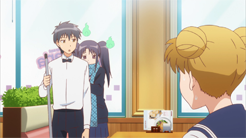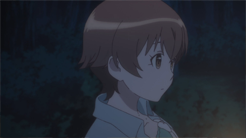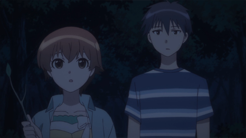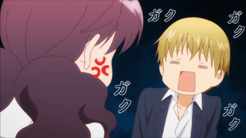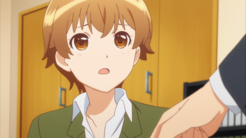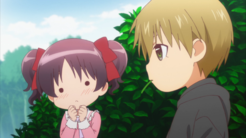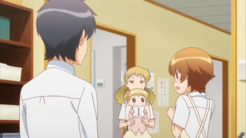





I really should be getting Grand Kingdom or waiting for Mirage Sessions. My review of Stella Glow is way past relevancy being nearly 8 months late, but I finally completed this and it wouldn’t hurt to briefly wrap up my thoughts about the game created by the now-defunct Imageepoch. I somehow managed to get through Lord of Magna in little over a week but I couldn’t motivate myself to finish this game after chapter 6. So first, jumping into the game, I admittedly didn’t have too much experience with much of Imageepoch’s previous titles, I only played Luminous Arc 1+2 and thought the gameplay was pretty good (although I’ll always hate the story in these kind of games). Therefore, I expected Stella Glow to be much of the same. In terms of its gameplay, it’s even somewhat over-simplified/dumbed-down since my last Imageepoch game.
To be brief, combat is turn-based spread over a 3D grid ala Luminous Arc, separated by free-times in which your character can buy weapon upgrades, find loot, do odd jobs for money, and interact with party members in order to unlock new support abilities. With combat, the atrocious AI aside, it’s relatively vanilla and doesn’t rock the conventions very much. It’s blasé to say the very least, with an outdated concept of PP-based skills that is actually a regress with its lack of any equivalent to Luminous Arc’s Flash Drives aside from the conducting (which doesn’t do much for strategic depth). There is no more depth beyond these standard attacks and skill-attacks, so what you see is what you get all the way through your 50+ hour game. Moving your team members around a strategically-lacking battle area has never felt more unexciting as a direct result, and makes grinding all the more painful to do. And you’re going to have to do a lot of it.
Compounding the problems to combat are the enemies. The AI in the game utilizes little form of strategy or out-maneuvering. If it has a better shot at greater damage output (such as attacking my characters from behind) it doesn’t do it, and as is the case almost all the time they rush the nearest available frailest unit and zerg-rush them without any semblance for party-cohesion/roles. For example, even when my tank Archibald is quite vulnerable sitting at a low health, enemies still often rush my witch who’s at full HP because the AI simply cannot understand strategy and the benefits of knocking down selective units. The challenge instantly turns to frustration as early game I didn’t even bother using healing units very often, since they have to come close to another party member in order to heal, yet then become vulnerable to long-range enemies’ ridiculous ranges. On the other hand, some skills thankfully offer low-mobility characters like Archibald with long range attacks to attack past 2 squares, which is sorely appreciated for such a slow unit, and it theoretically gives these characters better usage early-game with stronger party cohesion. However, this does not work as well as it should, as you often cannot attack diagonal squares aside from magic skills. For me, that defeats the purpose of trying to give slower units a greater mobility. Yes, Archibald gets better later on in the game, but there is little logic to not allowing long range attacks in general, Archibald or otherwise, to hit diagonal boxes especially when terrain heavily limits your ideal range of movement anyways. Some elements of Fire Emblem would’ve been great here, like diagonal attacks and earlier long range healing skills. Otherwise, everything else about the combat system is solid, such as the satisfying range of roles in your party, and the activities that you can do in between battle times are varied and interesting.
As for story, it’s about a generic protagonist with a mysterious past who has the power to collect witches, in true harem spirit–as is plastered all over the back cover. I’m not going to complain too much about the generic plot as much as I hate it, it’s simply there to provide a backdrop for the challenges that our characters will face after all, and none of the party members felt forced or too out of place. However, any longtime JRPG player will recognize the story going through the motions in a half hearted attempt to try and set these characters beyond their archetypes to no avail, and the writers have every blame for this. In a game like this it’s imperative for it to be a worthy character story, with immersive character conflicts to make up for the lackluster backdrop concerning some generic kingdom under attack by some generic villains. Unfortunately however, by the end, there is very little characterization. Well, apart from “She’s not shy anymore” and “He’s less strict now.”
Lastly, the user interface is clunky and bare bones to put it lightly. Whilst in battle, you cannot access an options menu to adjust your game settings, it is only available outside of that and events. Even then, the options menu is simply pathetic. There are volume sliders, options to turn off combat animation (which is already available in battle), and little else besides it. No options for changing the controls to adjust the inversion, utter disuse of the circle pad, story recaps, turtle paced scenes, and the list goes on. But at least the game looks good for the 3DS and the soundtrack isn’t half-bad, even if the fan service is irksome as hell and never stops, but that point is rather moot with a game like this that lets you know what you’re in for with the cover. Overall, if you haven’t picked this game up yet I’d recommend you give it a try at least, it’s honestly far better than the likes of Lord of Magna.
| Storytelling: |
5/10 Average fantasy story |
| Gameplay: |
7/10 Limitations aplenty, but otherwise strong system that remains familiar |
| User Interface: |
3/10 Clunky and frustrating |
| Production values: |
9/10 Looks and sounds great for the 3DS |
Suggestions:
Fire Emblem Fates
Luminous Arc
Lord of Magna

